Sektionsleiter | Section Chair: Mariana Neţ (“Iorgu Iordan – Al. Rosetti” Institute of Linguistics, Bucharest, Romania)
| Internet-Zeitschrift für Kulturwissenschaften | 17. Nr. | September 2012 | |
| Sektion 8.5. | The Urbanity of the World and the Dividing of Cities Sektionsleiter | Section Chair: Mariana Neţ (“Iorgu Iordan – Al. Rosetti” Institute of Linguistics, Bucharest, Romania) |
||
The Survival Modes of a modern vernacular commercial street in Israel:
Actual Survival in the city and as Simulations throughout Shopping Malls
Malka Ben-Peshat (Kibbutzim College of Education, Technology and Art, School of Graduate Studies, Visual Literacy in Education Department, Tel-Aviv, Israel) [BIO]
Email: benpeshat@gmail.com
Abstract
In a previous study (Ben-Peshat, 2007) I have been able to detect this double, or rather triple phenomenon of survival of a typical street defined as “modern vernacular”: first, its actual survival throughout the Israeli cities in spit of the invasion of the shopping malls, second, its canonization in popular and so cold high culture and third, the focus of this article, its appropriation in form of images and designed version in the “simulacrum” set of the shopping malls. Dose it indicate the replacing of the actual vernacular street in the sense of creating a new local environment, including a sense of belonging, Or, this kind of survival, rather stress the dying process of the typical vernacular street as part of destroying the small businesses by the “wild” building activities of malls.
Introduction
In a former study based on semiotic analysis, I have shown that a typical commercial main street, spread out in many cities and towns in Israel has aspects of what could be defined as “modern vernacular environment” (Ben-Peshat 2007). This definition(1) could be justified in regards to this typical street by being the outcome of a gradual, anonymous and collective creation which was adapted into local needs and social aspiration of communities, creating by that a sense of belonging to a place.
Indeed, this typical commercial main street was crystallized gradually by additional components since the 1950s, out of local conditions and genuine needs. It grew out of popular cultural climate and under social conditions of urban low middle class, on the background of an overall multicultural society. The cultural climate of its creation could be characterized as - rejection, eclectic appropriation and adaptation. The sterile European modernism that was imposed by national establishments in Israel during the 1950s, upon non-European immigrants, ignoring basic dwelling and living conditions (Shoken 2006) has been rejected and replaced by multicultural features being an outcome of eclectic appropriation from the local Palestinian popular culture and imported western modern and global elements. Its staggered signifiers include characteristics of skyline, façade, sidewalk and typical stores and street furniture. For example, components of the skyline, such as the sun heated boilers and TV antennas, typical stores like the “Oriental restaurant”, and the nuts and candies store nicknamed “Pizuzia” (“blast shop”), or the national lottery booths dominating the sidewalk in every corner. ( Ben-Peshat, 2007: 49) Some of these characteristics have won a cultural presence in different popular expressions, as well as in what is considered as “high” artistic genre exhibited in galleries and museums. Indeed, most of these components comprising this type of a street have acquired the status of popular icons in the sense that they are being admired in popular songs or conceptualized in exhibitions, reflected in ads, or even revived in a reality dramatized TV show filmed in a “Pizuzia”. (Ben-Peshat, 2007: 50-52).
In another level of cultural survival, certain components of the typical street have been appropriated and incorporated as street images and behaviors, “reenacted” in the “simulacrum” set of the shopping malls interior design and architecture. (Ben-Peshat, 2007: 52) The present article focuses on describing and analyzing this phenomenon, in order to raise some questions about its significance. Is survival of some of its characteristics and typical components throughout the malls, indicate the replacing of the actual vernacular street in the sense of creating a new local environment, including a sense of belonging, as might indicate a recent research about the importance the malls have acquired in consumers and leisure habits of contemporary Israeli society, (Gilboa, 2007). Or, that mode of survival, rather stress the dying process of the typical vernacular street as part of destroying the small businesses by the “wild” building activities of malls in Israel (Berger, 26.04.2007).
Actual Survival of the Street in the city outside of the malls
Apparently, the commercial segments in this modern vernacular street have survived the big wave of shopping malls that began in Israel in the mid 1980s; just when the typical commercial street have come to an age and acquired its whimsical nature as a “modern vernacular environment”. (Ben-Peshat, 2007: 52) Since then, 218 shopping malls and power centers were built and another 120 are planned to be built in the future. This huge number of shopping malls and power centers is without proportion to the small size of population in Israel populated by 7 million people (Coussin, 2004: 35, 44; Malki 2006; Berger, 26.04.2007). Much of the street characteristics of components and structure are still very much part of everyday life and of the texture of Israeli cities. Non the less, as a result of the “wild” building of roofed commercial centers of any sorts, the commercial segments of the typical street are very much weaken and in many cities they were seriously endangered (Shaul, 1994, 2000) The preservation of the typical street is sometime due to municipal restorations and renovations. A good and recent example is the renovation of Sokolov street in the City of Herzeliya. (Fig.15) However, in most towns and cities the commercial typical streets are in different states of degradation, expressed in facades elements, shops windows, sidewalks pavements, street furniture, lighting etc. In many cities, some streets almost turn into ruins as the small businesses are forced to close their stores due to the building of a shopping mall in their vicinity or in the suburbs. (Fig. 1) The over building of malls in Israel as in other parts of the world is sometimes part of gentrification processes when entire deteriorated urban areas undergo big renovation including the building of a mall which increase in property market values.
In many cases, the lower-income residents and small businesses owners who can no longer afford to live and make living there are forced to leave (Gonen, 2002;Grinberg, 17.12. 2007)(2).

Fig. 1: Old commercial center, Herzeliya (Photo by Malka Ben-Peshat)
Simulated modes of Survival of the Street inside the malls
The description and analysis of that phenomenon of “simulated survival” inside the malls is based on visual ethnographic research that I have conducted on a sample of 15 malls in 10 cities and towns throughout Israel: Tel-Aviv, Jerusalem, Haifa, Beer-Sheba â four big cities geographically spread in the center, north and south of Israel and 6 towns in central Israel, around Tel-Aviv: Holon, Bat-Yam, Ramat-Gan, Raanana, Herzeliya and Kefar-Saba(3) â In all of these representative malls one can notice the universal principle of street appropriation in malls all over the world. The visual codes of malls’ design in general combine among simulated images of street, palace and holy place, a pastiche amalgam of temple, church or a mosque (Goss, 1993). Malls in Israel do not make an exception.
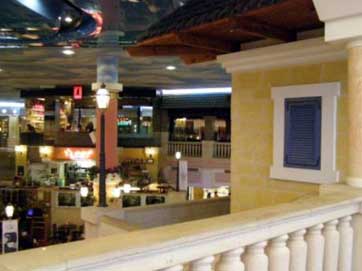
Fig. 2: Rural architecture with painted sky, Arena mall (photo by Malka Ben-Peshat)
Moreover, entrepreneurs, architects and designers of malls compete on luxuriousness and fanciness of architectural design. (Fig. 2) The Appropriation of the universal street is expressed by adopting fantastic images of romantic European city street or to a rural one, or in other cases, manly in the design shop windows, appropriated images of American inner city streets of black and Hispanic neighborhoods.
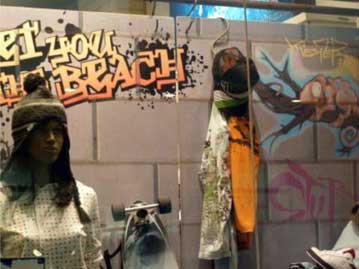
Fig.3: Street Fashion with graffiti’s, Renanim mall (Photo by Malka Ben-Peshat)
On top of that, I have detected a rich and representative repertoire of images or designed version of appropriated components from the typical modern vernacular street described above.
Accordingly, this repertoire of street appropriations in the Israeli malls, “universal” as well as local/vernacular, can be affiliated into two main instrumental types. Each type maintains several categories. In the first type the street appropriated characteristics serve, related to and concerned with the mall establishments, such as the management, the entrepreneur, the architects and designers and the brands corporate comprising the malls. Whereas, the second type, concerning the appropriation of the local street, apparently serve the needs of the wide public visiting the mall being in some sort a compromise to the strict management nature of the classical mall as being an isolated hyper-reality from the real street. (Baudriard, 1988)
The universal type categories: appropriated street characteristics, typical to most malls in the world serving the mall establishments:
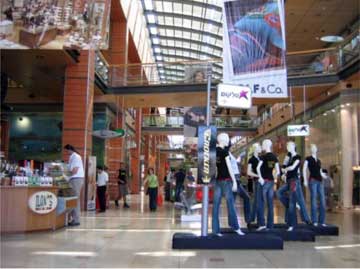 |
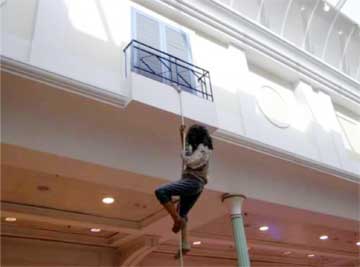 |
| Fig. 4: Street signage and sidewalk, 7 stars mall (Photo by Malka Ben-Peshat) | Fig. 5: “Thief” climbing to faked veranda, Renanim mall (Photo by Malka Ben-Peshat) |
The local type categories: appropriated street characteristics serving the wide public users or creating by them, “transgressing” in some extent the brand and franchise system dominance in the mall and creating leisure zone:
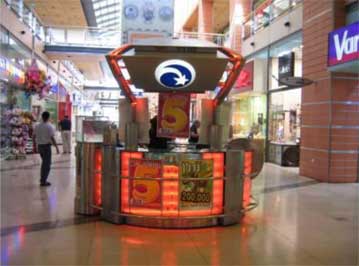 |
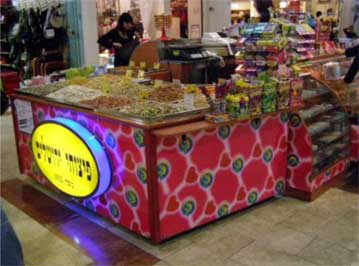 |
| Fig. 6: National Lottery booth, 7 stars mall (Photo by Malka Ben-Peshat) | Fig. 7: Pizuzia stand, Malcha mall (Photo by Malka Ben-Peshat) |
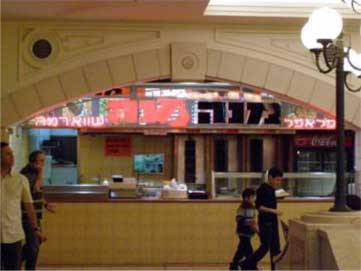 |
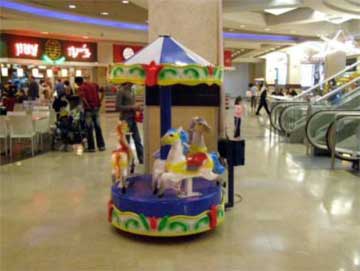 |
| Fig. 8: “Orintal restaurant”, Arena mall (Photo by Malka Ben-Peshat) | Fig. 9: Ride amusement for kids, Malcha mall (Photo by Malka Ben-Peshat) |
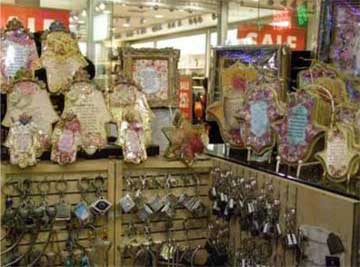 |
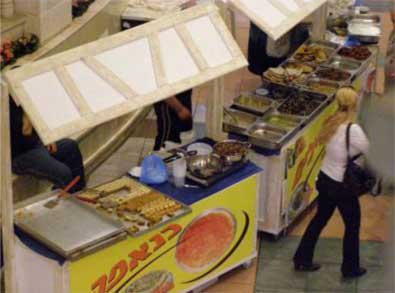 |
| Fig. 10: Talismans, Malcha mall (Photo by Malka Ben-Peshat | Fig. 11: Druze food, Arena mall (photo by Malka Ben-Peshat) |
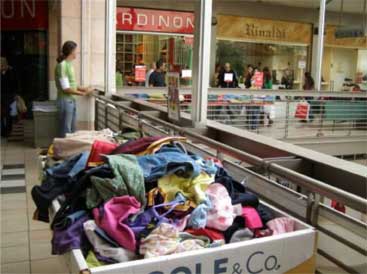 |
 |
| Fig. 12: Displayed cloths, Arim mall (Photo by Malka Ben-Peshat) | Fig. 13: Sitting on the floor, Malcha mall (Photo by Malka Ben-Peshat) |
On the level of baudriardian interpretation, which define the postmodern existential space in the context of Americanized consumer society, the universal incorporation of street images in the malls comprise of simulations and simulacra expressing escapism, disorientation and the phenomenon of exchanging reality into fiction (Baudriard, 1988, 1989); all that can be detected as a part of the Israeli version of hyper-reality in Americanizing local landscape. The Americanization of landscape in Israel is part of a global phenomenon, being connected also to its expression in mass media and in other cultural expression, and yet it has its local flavor. On a level of contemporary socioeconomic interpretation of the public spaces, if malls can be considered as such, one can understand the combination of appropriating universal and vernacular street images in Israeli malls as an expression of “glocalization”, as Rodrigo Salced (2003) describe in his article “When the Global Meets the Local at the Mall”: the “combination of the post-
Fordist capitalist logic of the mall with local characteristics that affect mall development” (Salced, 2003: 1084). However, “glocalization” should not blur the aspect of compromise the presence of the modern vernacular street signs represent for the malls establishment in principle, especially, everything that concerns the popular type of merchandise and behavioral signs (the c, d, e, f categories). This compromise can be understood in both ways. One way, is on the light of the recent economic trend to turn the mall into a kind of “community center”, a place for leisure that include maximum functions for services and entertainment. This trend represents efforts to avoid the phenomenon of malls failure and closure that occurred in America during the nineties, as a result of malls building inflation.(Shaul, 2000, Burger, 2007). The incorporation and the significant presence of components from the modern vernacular street, even in a stylized fancy redesigned version, throughout the shopping malls provide to the public familiar spots to identify with through the “hyper-realty” of the mall. That leads to the other way of understanding this compromise, in the light of De Certeau (1984) theory of everyday practices, according to which the users manipulate the conditions imposed on them by the powers of establishment representatives by reorganizing spaces and behaviors to match their needs and aspirations.
However, on that point, the question that should be asked is whether this modus of survival, as penetration or infiltration of the local street elements into the malls through user’s behavior and merchandise bring the mall spaces closer to the public space qualities of the real street? In other words, did it represent a real change of the malls into “community centers”? A picture of an old person lying on a bench approached by security can be the answer to that. (Fig.14)
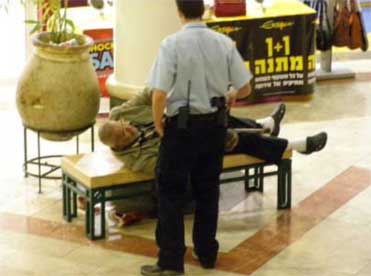
Fig. 14: Security approaching old man, Malcha mall (Photo by Malka Ben-Peshat)
That question leads our interest back to the real state of the modern vernacular street. It seems that the authentic commercial street, a type that took about thirty years to develop and crystallize as a vernacular organic expression is going through changes too, ironically, in the contexts of its renovation project. For example, examining the redesign ofâ Sokolov street at the center city of Herzelia and Jaffa main commercial street at Jerusalem, one can detect two features: first, (fig.15) the design language is taken from the shopping mall, such as, large and slick marble-like paved sidewalks designed with squares and circles patterns, fancy street furniture and sculptural lighting pots; this type of design, in a certain extent, is fazing out the typical old vernacular sign of “promiscuity” (Ben-Peshat, 2007: 50). Second, (fig.16) commemorating, as part of the renovation, the old historic phase of the street and city from periods before the establishment of the state of Israel, on huge wall painting of old nostalgic photographs depicting old ruined missing buildings in the street.
Both, by adopting some visual codes and aesthetics from the shopping mall, and by practicing nostalgic commemorating acts, the renovated street approach well designed fiction that actually disguises a sense of sublimation of an absent real.
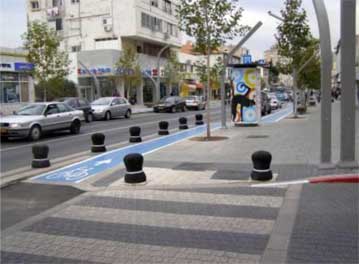 |
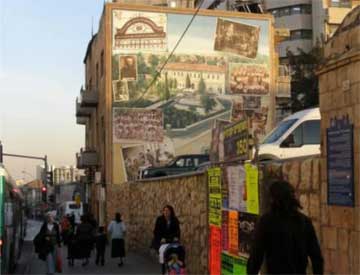 |
| Fig. 15: Renovated Sokolov street, Herzelia | Fig.16: Nostalgic wall depicting the absent of Aliance School (Photo by Malka Ben- Peshat) |
In that regard of preserving the memory of historic sites, the case of Mamila shopping avenue located in Alrov quarter in front of the old walls vis-a-vis the Jaffa gate towards
the old city of Jerusalem, has a special interest. This mall was opened to the public in the summer 2007. (Fig. 17, 18) The Mamila avenue is part of the Israeli, internationally known architect Safdi restoration project of the Jewish 19th century Mamila quarter, a complicated project which last more then 30 years. (Zandberg , 31.5.07) It seems that the architect and planners have aspired to form of the Mamila avenue a connecting bridge between the western city and the old eastern part of the city. (Arfa, 2007). The Mamila open mall was planned and designed in an old street style using parts of a reconstructed street connected to a mostly redesigned part, as an open shopping mall avenue; that mall comprises only of exclusive and expensive brand stores. In one of the articles published to the occasion of its opening it was compared to “The Grove” in Los Angeles. (Arfa, 2007) On a wall of a corridor leading to the huge underground parking lot are hanging adds proposing lectures about vitamins and beauty issues, lectures relating the history of Mamila quarter or even a drum show for peace. However, none of the popular and fairish affordable attractions for grown up and children, or other components appropriated from the vernacular street present in other malls in order to attract the masses are offered here, not to mention other reminiscence of the typical vernacular street, such as oriental restaurant, pizuzia and lottery booths. Therefore, Instead of being a connecting bridge it actually creates a segregating zone, inviting only exclusive and very rich public, excluding both low income Jewish citizens from the western city and Arab citizens of the eastern part of the city. This segregation is created through economic, design and architectural means, which physically disconnect it from Jaffa Street in the west and Jaffa gate at the east.
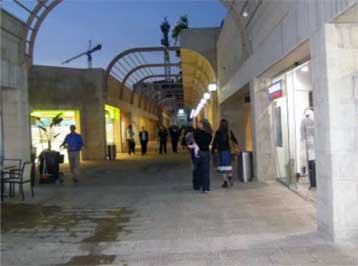 |
 |
| Fig. 17: Mamila open mall (Photo by Malka Ben-Peshat) | Fig. 18: Mamila open mall, reconstructed part with posters (Photo by Malka Ben-Peshat) |
Closing
The Mamila case represents an extreme type of simulation in the Baudriardian sense, in which the partial restoration of the old 19th century street incorporated in a pastiche architecture of the Mamila project, like Disneyland is a kind of camouflage to a real absence, both of old memory of the 19th century street and of the recent memory of the 20th vernacular street which elements can be detected not far away in the neglected and in parts almost deserted Jaffa street. This state of degradation the commercial center of Jerusalem is going through was caused by over building of malls in the capital â 10 including the Mamila mall.(Shoken, 31.9.05) Moreover, by totally ignoring the modern vernacular street, the Mamila open mall is a test case that throws light on the modus of survival and meaning of conservation of those street elements in the other, older malls. Indeed, one might understand the presence of street elements throughout the Israeli malls, both in physical and behavioral level, as a penetration of the street into the mall, in the context of “incorporating the city”, including elements of the vernacular street. In that case, in a De Certeau manner of thinking about the “victory of the weak upon the strong”, is it a sign of “vengeance”, from the part of the modern vernacular street by gradually invading the same malls which represent the constant menace, and taking dominance over them? Can it by the continuation of the postmodern developing process that same street went through in reaction to the modernistic street of the1950s? At the same token, the metamorphosis of the vernacular street in the shopping malls, simulated as a survival modus in a commercial context for commercial ends dose not erase the damages inflicted by the malls or avoid it in the future to large commercial areas of small businesses which have developed since the 1950s in many cities and towns of Israel. The real modern vernacular typical commercial street is still struggling for its life with hundreds of malls, power centers and with its proliferated simulations inside them. Some of the components of the Street were immortalized, though in the arts and mass media arena, where they are canonize and iconize into modern mythologies, however, disconnecting them from the city texture into a virtual and spiritual sphere.
Bibliography
Notes:
8.5. The Urbanity of the World and the Dividing of Cities
Sektionsgruppen | Section Groups | Groupes de sections
| Inhalt | Table of Contents | Contenu 17 Nr. |
Webmeister: Gerald Mach last change: 2012-09-04